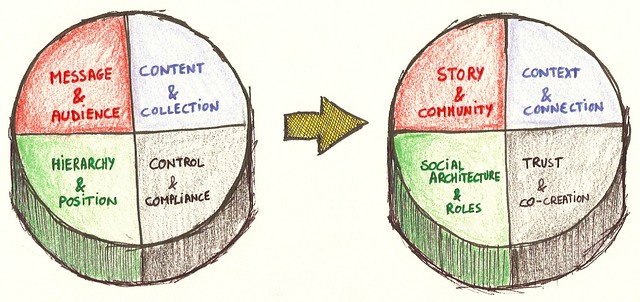When we invert our traditional thinking about what is cause and effect we can redirect the focus of our attention and efforts. This is exactly what is needed when we want to talk about community development.
Last week I zoomed in on the insights of Peter Block on what it takes to transform a community. This led me to the insight that our profession as organizational change practitioner is no longer that of a problem solver. Our work is to build the capacity of community members to be accountable and to become creators of community.
In this article I want to zoom in on what it takes for us as so-called ‘leaders’. Again I am pulling out the Peter Block’s book Community: the Structure of Belonging, because it serves once more as a roadmap for to shift our thinking.
Upside Down
When we are open to thinking along the lines that followers create leaders, that children create parents, and that the audience creates the performance, we create the conditions for communities to develop. According to Peter Block:
The default culture would have us believe that the past creates the future, that a change in individuals causes a change in organizations and community and that people in authority create people in a subordinate position. That we are determined by anything aside from free will.
In his book he gives great examples of inversions, for example: ‘the subordinate creates the boss’. The direct implication would be that learning, development and goal setting would be in the hands of the subordinate. The attention would shift from the boss to peers, which is the relationship that produces the work.
Matching Block’s Insights to the Change Management Portfolio
It didn’t take long for my brains to itch and scratching led me to return to an idea that I published in 2011 on the future of our profession. I used the ice hockey metaphor to point out where organizational change practitioners should be today, and the direction the puck will be heading tomorrow.

On the left-hand side of the drawing above, you can see what change management execution was about before the digital economy got any traction:
- Communication: broadcast your messages to stakeholders (‘Message & Audience’)
- Learning: manage the curriculum (‘Content & Collection’)
- Organization: top-down (‘Hierarchy & Position’)
- Performance: push harder (‘Control & Compliance’)
However, as we are witnessing the end of the Industrial Revolution, we discover that leadership and workplace dynamics are no longer hierarchical. That game is over. Compliance is no longer the shortest path to productivity. When the world changes, the rules change.
This is where we need to invert our thinking about what is what is cause and effect in order for communities to develop. The truth is that relationships are no longer hierarchical, they have become tribal – aka: ‘influence without authority’.
If we want to skate where the puck is going to be, we need to confront the entitlement and dependency that we maintain with our traditional thinking. Inverting our thinking does not change the world, but we will redirect out attention, training and resources to where we believe cause resides. Different things will become possible.
This means that the new ‘inverted’ puck of Organizational Change looks like this:
- Communication: listen and trust the process (‘Story & Community’)
- Learning: learning is in the network (‘Context & Connection’)
- Organization: become a platform for change (‘Social Architecture & Roles’)
- Performance: balance push and pull (‘Trust & Co-creation’)
Here’s a question to start the week: which inversions would you make in your approach and how would that change the way you focus your attention, training and resources?


